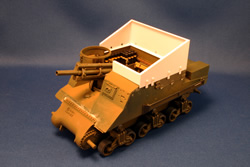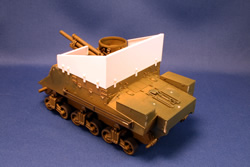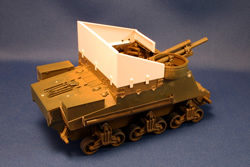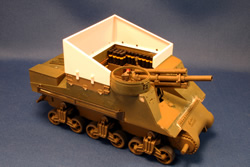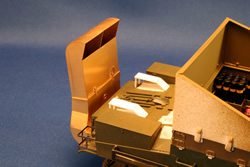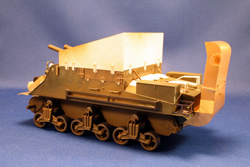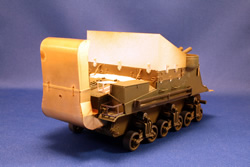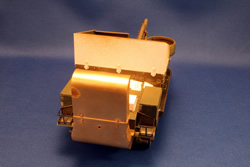Tackling the ExteriorThe
exterior of Baboon is where the most significant changes are made. In spite of
the reference photos, the wading walls were a particular puzzlement. The Tankograd
manual shows a different version, British-made, than the wall kit that Baboon
sported. With the British kit, the hinged upper wall segments on either side were
lowered and the wading kit was secured in place. On Baboon, however, the short
walls remained in place and the wading walls sat atop them, any cracks and gaps
sealed with asbestos grease. Based on the photos, I presumed that bracing was
welded to the Priest structure, and then the wading walls were bolted into place.
There was probably a canvas sheet smeared with asbestos grease tucked under the
gun like a bib, and similar waterproofing applied to the fuel caps and air intake
on the back engine deck. The main thing was to keep water out of the engine, and
try to keep the crew compartment as dry as possible for the short trip from the
landing craft to the beach. The Pathe newsreel frames show the canvas missing
from the front; perhaps this was torn away immediately to allow the gun to move
freely should it require immediate use? But given that Baboon landed on D+4, I
suppose there's any number of reasons why it was removed before the vehicle left
the beach. I estimated the sizes of the wading wall segments from the photos,
and made some cardboard templates. When I was satisfied with the size and fit,
I cut the real parts from plastic sheet stock. I reinforced them with angle stock
as I thought would be appropriate. You can see below how the unit looked before
gluing in place. Once satisfied with the fit, I sprayed the inner walls, which
would allow me to mask off and avoid overspray on the already painted and weathered
interior. The
keen observer will note that the added armor walls on the side and rear of the
compartment look quite like the Italeri kit. And indeed they are. I used photoetch
parts from the Voyager Models set for the Academy kit, but did not relish all
of the monkeying around with plastic card and aligning a lot of brass bits that
for the bolts, and the hinges are oversized and incorrectly shaped (square edges
rather than round). So I cut out the Italeri parts from my spare kit and they
fit fine. The wading trunks covering the rear exhaust are from Eduard. I was able
to bend them carefully without the aid of a bend-and-fold device; I just used
my metal straightedge and the chisel blade of my X-acto knife. I reinforced the
joints with plastic strip stock and a healthy does of super glue. It's a bit tricky
because you need to fold things correctly and there is not much tolerance for
error. The lower unit coming off of the rear engine plate is the first segment,
and the two-part stack is assembled independently. Fortunately, I had no problem
dryfitting them together. The
Priests in the field artillery battalions of the 2nd Armored Division were noted
for having side stowage racks virtually identical to those seen on M3A1 half-tracks.
Luckily, I had a spare set from a Tamiya kit, so on they went. Other changes to
the exterior include removing the tie downs from the front sides of the superstructure,
adding tubes to the walls that were used to hold up camo netting, and adding the
armored plates over the vents (made from plastic as they are not included in the
Voyager set for some odd reason). The gas can racks on the rear fenders are left
over from an Eduard set. 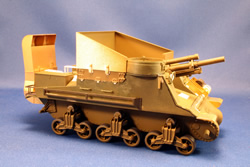 | 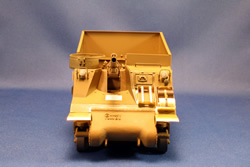 |
The
fenders and stowage boxes on the glacis are from Voyager. I opted to thin down
the kit's brush guards over the headlights. A grab bar was added to the roof over
the driver's compartment, another distinctive element of 2AD Priests. Archer Fine
Transfers provided the weld beads around the superstructure. I didn't take the
horizontal bead all the way across the front glacis joint nor did I add the small
stowage compartment to the right since they would be covered by the large roll
of camo netting. The
Historical Baboon
Updating
the Interior
Tackling the Exterior
Painting,
Decals, and Weathering
The
Diorama: "Lafayette, Baboon Has Arrived!" |













